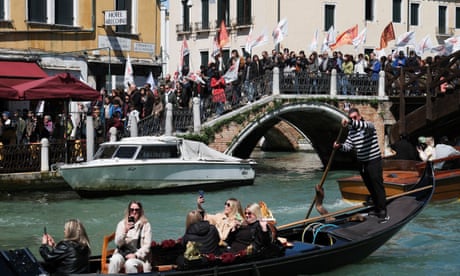
Venice’s entrance charge for day trippers has got off to a shaky start, bewildering people staying in hotels who needed to prove their exemption and drawing protests from some residents.
The €5 (£4.30) charge, aimed at curtailing over-tourism, has ignited fury among some residents. The charge kicked in at 8.30am on Thursday and will apply on 29 peak days until 14 July as part of a trial phase.
Most of the day trippers arriving at Santa Lucia station came prepared with a QR code proving they had paid the €5 toll, but the initiative caused confusion among people staying in hotels who were unaware they had to go through the rigmarole of confirming their exemption online.
Showing proof of a hotel booking is not enough, as Yvonne McKenna and Ken Mehan, visitors from Ireland who had arrived on an overnight train from Vienna, learned. A steward guided the couple through the online process, which took about 10 minutes.
“I knew about the new tax and the exemption but I didn’t know we would be doing this when we arrived,” said McKenna. “It does seem to take a long time … Imagine if you weren’t so up on all the technology.”
As more trains arrived at the station, Mehan pondered how easy it will be to manage the controls in high season. “I understand why they’re trying to do it, but it feels as though it could be a recipe for disaster.”
Natalie Liddell, a visitor from York in Venice for the first time, said: “It is very confusing. When we got to the hotel they said something about this, but we didn’t quite get what they were talking about. But I don’t think €5 is going to put people off.”
Others were totally oblivious to the new measure. “What fee?” asked Elizabeth from the US, before being taught how to pay online.
The initiative has been bitterly contested in Venice, with opponents arguing that it is against the principle of freedom of movement and will do nothing to meaningfully address over-tourism.
Venice’s main island, where the measure applies, attracted 3.2 million overnight visitors in 2022. On the busiest days, an average 40,000 day trippers arrive in the city.
There was tension between police dressed in riot gear and the estimated 500 people protesting against the fee at Piazzale Roma, where Venice’s main bus terminal is.
Federica Toninello, one of the protest’s organisers, said: “None of the measures done by this council cater to the necessities of residents. It’s just tourism and speculation, this is why we’re angry.”
Toninello said that even though Venetians were exempt, the measure still affected their everyday lives as they had to prove they were not liable for the charge and were subjected to checks. Likewise, commuters or students have to endure “the impracticality” of obtaining a QR code.
Guido Sattin, an activist from Arci, handed out “symbolic passports” to tourists outside the station as a way of highlighting the “dubious constitutional legitimacy” of the measure in terms of restricting free movement.
“This sets a dangerous precedence,” he said. “We are the only city in the world that you have to pay to enter. This goes against the Italian constitution and the European principle of freedom of movement.”
Simone Venturini, Venice’s tourism councillor, defended the council’s move. “These protesters consider us to be the enemy,” he said. “This is not a magic wand measure, but after 60 years of talking about how to manage tourism, this is the first time anyone has taken action.”
Venturini said the fee was mostly aimed at deterring Italian day trippers. “For example, a lot of Italians come to the nearby beaches in summer and on a rainy day, they overwhelm Venice. Yes, the majority are from Veneto and are exempt, but the fact they still have to go online to confirm this is a way to disincentivise them.”
Jana Plevova, from Prague, sympathised with the residents’ plight, but supported the fee. She was spending five nights in the city and so was exempt as she already paid a nightly tourist tax, but said she would have no qualms paying to enter for the day.
She said: “Prague is also suffering from over-tourism, so paying €5 is not that much for trying to preserve this beauty and architecture.”
Edel, from Ireland, said: “For me, €5 is nothing if you really want to come.” Her husband, John, was more sceptical. “It’ll be €5 this year, €10 next … Who knows what the price will be in a few years’ time? Venice will stop living off its good name and start being seen as a rip-off.”